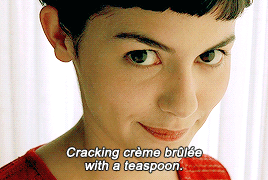Untitled

Untitled
by: Jannik Obenhoff
More Posts from Smparticle2 and Others










» Medical Specialties «
It’s a terrible thing, I think, in life to wait until you’re ready. I have this feeling now that actually no one is ever ready to do anything. There is almost no such thing as ready. There is only now. And you may as well do it now.
Hugh Laurie (via liberatingreality)




:)

If you liked The Map of Physics animation, I bet you’ll like The Map of Mathematics too (also by Dominic Walliman):
h-t Open Culture
There is a time when it is necessary to abandon the used clothes, which already have the shape of our body and to forget our paths, which takes us always to the same places. This is the time to cross the river: and if we don’t dare to do it, we will have stayed, forever beneath ourselves
Fernando Pessoa (via paizleyrayz)
Sleeping brain's complex activity mimicked by simple model
Researchers have built and tested a new mathematical model that successfully reproduces complex brain activity during deep sleep, according to a study published in PLOS Computational Biology.

Recent research has shown that certain patterns of neuronal activity during deep sleep may play an important role in memory consolidation. Michael Schellenberger Costa and Arne Weigenand of the University of Lübeck, Germany, and colleagues set out to build a computational model that could accurately mimic these patterns.
The researchers had previously modeled the activity of the sleeping cortex, the brain’s outer layer. However, sleep patterns thought to aid memory arise from interactions between the cortex and the thalamus, a central brain structure. The new model incorporates this thalamocortical coupling, enabling it to successfully mimic memory-related sleep patterns.
Using data from a human sleep study, the researchers confirmed that their new model accurately reproduces brain activity measured by electroencephalography (EEG) during the second and third stages of non-rapid eye movement (NREM) sleep. It also successfully predicts the EEG effects of stimulation techniques known to enhance memory consolidation during sleep.
The new model is a neural mass model, meaning that it approximates and scales up the behavior of a small group of neurons in order to describe a large number of neurons. Compared with other sleep models, many of which are based on the activity of individual neurons, this new model is relatively simple and could aid in future studies of memory consolidation.
“It is fascinating to see that a model incorporating only a few key mechanisms is sufficient to reproduce the complex brain rhythms observed during sleep,” say senior authors Thomas Martinetz and Jens Christian Claussen.

(Image caption: New model mimics the connectivity of the brain by connecting three distinct brain regions on a chip. Credit: Disease Biophysics Group/Harvard University)
Multiregional brain on a chip
Harvard University researchers have developed a multiregional brain-on-a-chip that models the connectivity between three distinct regions of the brain. The in vitro model was used to extensively characterize the differences between neurons from different regions of the brain and to mimic the system’s connectivity.
The research was published in the Journal of Neurophysiology.
“The brain is so much more than individual neurons,” said Ben Maoz, co-first author of the paper and postdoctoral fellow in the Disease Biophysics Group in the Harvard John A. Paulson School of Engineering and Applied Sciences (SEAS). “It’s about the different types of cells and the connectivity between different regions of the brain. When modeling the brain, you need to be able to recapitulate that connectivity because there are many different diseases that attack those connections.”
“Roughly twenty-six percent of the US healthcare budget is spent on neurological and psychiatric disorders,” said Kit Parker, the Tarr Family Professor of Bioengineering and Applied Physics Building at SEAS and Core Faculty Member of the Wyss Institute for Biologically Inspired Engineering at Harvard University. “Tools to support the development of therapeutics to alleviate the suffering of these patients is not only the human thing to do, it is the best means of reducing this cost.“
Researchers from the Disease Biophysics Group at SEAS and the Wyss Institute modeled three regions of the brain most affected by schizophrenia — the amygdala, hippocampus and prefrontal cortex.
They began by characterizing the cell composition, protein expression, metabolism, and electrical activity of neurons from each region in vitro.
“It’s no surprise that neurons in distinct regions of the brain are different but it is surprising just how different they are,” said Stephanie Dauth, co-first author of the paper and former postdoctoral fellow in the Disease Biophysics Group. “We found that the cell-type ratio, the metabolism, the protein expression and the electrical activity all differ between regions in vitro. This shows that it does make a difference which brain region’s neurons you’re working with.”
Next, the team looked at how these neurons change when they’re communicating with one another. To do that, they cultured cells from each region independently and then let the cells establish connections via guided pathways embedded in the chip.
The researchers then measured cell composition and electrical activity again and found that the cells dramatically changed when they were in contact with neurons from different regions.
“When the cells are communicating with other regions, the cellular composition of the culture changes, the electrophysiology changes, all these inherent properties of the neurons change,” said Maoz. “This shows how important it is to implement different brain regions into in vitro models, especially when studying how neurological diseases impact connected regions of the brain.”
To demonstrate the chip’s efficacy in modeling disease, the team doped different regions of the brain with the drug Phencyclidine hydrochloride — commonly known as PCP — which simulates schizophrenia. The brain-on-a-chip allowed the researchers for the first time to look at both the drug’s impact on the individual regions as well as its downstream effect on the interconnected regions in vitro.
The brain-on-a-chip could be useful for studying any number of neurological and psychiatric diseases, including drug addiction, post traumatic stress disorder, and traumatic brain injury.
"To date, the Connectome project has not recognized all of the networks in the brain,” said Parker. “In our studies, we are showing that the extracellular matrix network is an important part of distinguishing different brain regions and that, subsequently, physiological and pathophysiological processes in these brain regions are unique. This advance will not only enable the development of therapeutics, but fundamental insights as to how we think, feel, and survive.”
The Beauty of Webb Telescope’s Mirrors
The James Webb Space Telescope’s gold-plated, beryllium mirrors are beautiful feats of engineering. From the 18 hexagonal primary mirror segments, to the perfectly circular secondary mirror, and even the slightly trapezoidal tertiary mirror and the intricate fine-steering mirror, each reflector went through a rigorous refinement process before it was ready to mount on the telescope. This flawless formation process was critical for Webb, which will use the mirrors to peer far back in time to capture the light from the first stars and galaxies.

The James Webb Space Telescope, or Webb, is our upcoming infrared space observatory, which will launch in 2019. It will spy the first luminous objects that formed in the universe and shed light on how galaxies evolve, how stars and planetary systems are born, and how life could form on other planets.
A polish and shine that would make your car jealous

All of the Webb telescope’s mirrors were polished to accuracies of approximately one millionth of an inch. The beryllium mirrors were polished at room temperature with slight imperfections, so as they change shape ever so slightly while cooling to their operating temperatures in space, they achieve their perfect shape for operations.

The Midas touch
Engineers used a process called vacuum vapor deposition to coat Webb’s mirrors with an ultra-thin layer of gold. Each mirror only required about 3 grams (about 0.11 ounces) of gold. It only took about a golf ball-sized amount of gold to paint the entire main mirror!

Before the deposition process began, engineers had to be absolutely sure the mirror surfaces were free from contaminants.

The engineers thoroughly wiped down each mirror, then checked it in low light conditions to ensure there was no residue on the surface.

Inside the vacuum deposition chamber, the tiny amount of gold is turned into a vapor and deposited to cover the entire surface of each mirror.

Primary, secondary, and tertiary mirrors, oh my!
Each of Webb’s primary mirror segments is hexagonally shaped. The entire 6.5-meter (21.3-foot) primary mirror is slightly curved (concave), so each approximately 1.3-meter (4.3-foot) piece has a slight curve to it.

Those curves repeat themselves among the segments, so there are only three different shapes — 6 of each type. In the image below, those different shapes are labeled as A, B, and C.

Webb’s perfectly circular secondary mirror captures light from the 18 primary mirror segments and relays those images to the telescope’s tertiary mirror.

The secondary mirror is convex, so the reflective surface bulges toward a light source. It looks much like a curved mirror that you see on the wall near the exit of a parking garage that lets motorists see around a corner.

Webb’s trapezoidal tertiary mirror captures light from the secondary mirror and relays it to the fine-steering mirror and science instruments. The tertiary mirror sits at the center of the telescope’s primary mirror. The tertiary mirror is the only fixed mirror in the system — all of the other mirrors align to it.

All of the mirrors working together will provide Webb with the most advanced infrared vision of any space observatory we’ve ever launched!
Who is the fairest of them all?
The beauty of Webb’s primary mirror was apparent as it rotated past a cleanroom observation window at our Goddard Space Flight Center in Greenbelt, Maryland. If you look closely in the reflection, you will see none other than James Webb Space Telescope senior project scientist and Nobel Laureate John Mather!

Learn more about the James Webb Space Telescope HERE, or follow the mission on Facebook, Twitter and Instagram.
Make sure to follow us on Tumblr for your regular dose of space: http://nasa.tumblr.com.






Amélie doesn’t have a boyfriend. She tried once or twice, but the results were a let-down. Instead, she cultivates a taste for small pleasures.

The winners of the Miss Perfect Posture contest at a chiropractors convention, USA, 1956
via reddit
-
 motovilka reblogged this · 4 months ago
motovilka reblogged this · 4 months ago -
 thelovelygods reblogged this · 4 months ago
thelovelygods reblogged this · 4 months ago -
 mimi19art liked this · 2 years ago
mimi19art liked this · 2 years ago -
 softcoolwind reblogged this · 3 years ago
softcoolwind reblogged this · 3 years ago -
 m-clair liked this · 3 years ago
m-clair liked this · 3 years ago -
 spookyanxietygirl liked this · 4 years ago
spookyanxietygirl liked this · 4 years ago -
 thephotographypalace reblogged this · 5 years ago
thephotographypalace reblogged this · 5 years ago -
 sigma-tau liked this · 5 years ago
sigma-tau liked this · 5 years ago -
 nothing-is-forever1 liked this · 6 years ago
nothing-is-forever1 liked this · 6 years ago -
 ti---a liked this · 6 years ago
ti---a liked this · 6 years ago -
 weronika-kowalczyk reblogged this · 6 years ago
weronika-kowalczyk reblogged this · 6 years ago -
 i-find-bliss-in-every-kiss reblogged this · 6 years ago
i-find-bliss-in-every-kiss reblogged this · 6 years ago -
 invisiblem liked this · 6 years ago
invisiblem liked this · 6 years ago -
 saintgoner reblogged this · 6 years ago
saintgoner reblogged this · 6 years ago -
 ssauna reblogged this · 6 years ago
ssauna reblogged this · 6 years ago -
 prilluminaughty liked this · 6 years ago
prilluminaughty liked this · 6 years ago -
 kaleo75sunshine liked this · 6 years ago
kaleo75sunshine liked this · 6 years ago -
 ismile2much liked this · 6 years ago
ismile2much liked this · 6 years ago -
 f4ck-the-p0lice liked this · 6 years ago
f4ck-the-p0lice liked this · 6 years ago -
 don-alhussain liked this · 6 years ago
don-alhussain liked this · 6 years ago -
 stonehen-ge reblogged this · 6 years ago
stonehen-ge reblogged this · 6 years ago -
 entonisav liked this · 6 years ago
entonisav liked this · 6 years ago -
 kabon liked this · 6 years ago
kabon liked this · 6 years ago -
 fairfarrenfawn reblogged this · 6 years ago
fairfarrenfawn reblogged this · 6 years ago -
 hereistheworld liked this · 6 years ago
hereistheworld liked this · 6 years ago -
 g-mav liked this · 6 years ago
g-mav liked this · 6 years ago -
 scoutii reblogged this · 6 years ago
scoutii reblogged this · 6 years ago -
 birdy4 liked this · 6 years ago
birdy4 liked this · 6 years ago -
 evabru liked this · 6 years ago
evabru liked this · 6 years ago